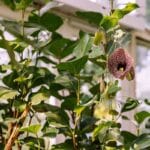In designing a landscape or a garden, functionality and beauty should go hand-in-hand. Keeping this in mind, Cypress Vine is a good candidate. It brings softness and color to the landscape thanks to its leaves and flowers. Also, this vine grows vastly almost anywhere as long as it is exposed to full sun.
However, it may also be a potential pest and threat, so maintenance activities play a vital role in controlling it.
Botanical Information
Ipomoea quamoclit goes by the names Cypress Vine, Hummingbird Vine, Star-glory, Cypressvine Morning Glory, Cardinal Creeper, Cardinal Vine, and Cardinal Climber. The vine was called Hummingbird Vine due to the abundance of hummingbirds as their visitor, which is no surprise since they come from the Convolvulaceae family.
This plant is a cousin of one of the crowd favorites, the Morning Glory plant, and most flowering plants under this family produce flowers that are eye-catching for humans and wildlife.
Spatial Distribution
The Cypress Vine is native to Central America and Mexico. As a tropical plant, the vine flourishes during summer and in hot weather conditions. Given this, the plant thrives in USDA Zones 11 to 12, where the average temperature is warm enough in favor of the Cypress Vine.
Furthermore, the plant is naturalized in different parts of America, across New York, Illinois, Missouri, Florida, Texas, and Kansas.

Growth Habits
As a tropical plant, the Cypress Vine tends to grow vastly by twining and clinging to structures. Its average height is around 6 to 10 feet, but sometimes can extend up to 20 feet. Meanwhile, it is usually 3 feet wide and could grow up to 6 feet.
This plant is one of the easy-to-grow vines in the landscape since it requires minimal maintenance but provides both functionality and aesthetics. Furthermore, this vine is an annual deciduous plant that produces enchanting flowers during Fall and Summer.
Leaves
The Cypress Vine has a soft stem that will not exceed 2 cm in girth. Attached to it are green leaves that resemble a fern due to its threadlike appearance, affixed to each side of the stem like a feather. Also, each leaf extends from 2 to 4 inches in length.
Flowers
As the main attraction, this vine’s flowers are showy and attention-grabbing for landscape users and wildlife. Same with most of its sisters in the Convolvulaceae family, the Cypress Vine gives rise to tubular flowers with its petals forming a star shape with its five lobes.
Aside from the shape of this flower, what makes it attractive is its scarlet-red color visible in three-fourths of the flower. At the flower’s base, sepals are present. Moreover, terminal flowers are the first to develop, followed by blooms in the lateral buds.
Fruit and Seeds
As the plant matures, star shaped flowers turn to fruits when fertilized through pollination, and 3 to 4 seeds are then produced. Seeds are around 5 to 6 millimeters long and 2 to 3 millimeters wide, with tiny hairs and spots protruding at the surface. Also, protrusions of wart-like structures are often seen around the hilum of the seed.

Grow and Care Tips
Sun Requirement
Knowing the Cypress Vine’s tropical origins shows that the plant loves to be under the sun. It will flourish when exposed to full sun, but can also tolerate partial shade.
However, the chances of having fewer flowers to no flowering will increase, especially when the uninterrupted 6 hours of full sunlight exposure is not provided.
Water Requirement
This fast-growing plant does not require much moisture. Aside from being a sun-loving plant, it is also drought resistant. On the other hand, wet soils are not a problem for it too. In general, regularly water the plant on average amounts frequently, which is at least 3 to 4 times a week.
The watering program will also depend on the status of both the plant and the potting soil. Observing its growth and checking if the soil is dry will determine how frequent watering is needed.
Temperature and Humidity
A warm and moist environment is most suitable for this vine’s growth.
Soil Requirement
Since the Cypress Vine is a sturdy plant, it flourishes in most soils as long as there is good drainage. It also thrives in areas wherein the soil is sometimes too dry or too wet. In terms of the pH of the soil, cypress vines grow in either neutral, acidic, or alkaline soils.
Fertilizer Requirement
Application of fertilizer is rarely done for this plant as long as the soil is rich in organic matter. However, soil testing is still preferred to know which nutrient is to be supplied. Keep in mind that applying nitrogen-rich fertilizers before flowering may hinder the formation of flowers.
Whereas, applying phosphorus-rich fertilizers will help the plant optimize its flower production.

Maintenance Activities
Light pruning for this vine is recommended to keep the plant healthy and aesthetically pleasing. Removal of dead plant parts and outgrowths will be the ones to be removed while pruning. Also, the Cypress Vine is often dependent on the supporting structures to where it twines.
Therefore, maintenance of the materials used for their anchorage should also be checked regularly for damages that may harm the plant.
Moreover, this vine may become unruly when left untouched and could lead to disruption to other existing vegetation in the landscape. In this case, it is advised to perform extensive pruning to keep the plant in control.
Since pruning is the key maintenance activity this plant needs, ensure that the tools to be used should also be cleaned and sanitized to prevent infection to some diseases. Cleaning the tools should be part of the standard operating procedure when tending a landscape.
Propagation
Propagation of the Hummingbird vine is done naturally by seeds or asexually by stem cuttings. Seeds are often distributed through wind, water, birds, bees, and butterflies making them less laborious.
On the other hand, choosing stem cuttings as a propagation method will require more effort. In using stem cuttings as planting material, it is important to choose the right stem to cut. Actively growing stem parts should be selected with some leaves attached to the stem.
Whereas, the planting media should have good drainage and water holding capacity. Dipping the stems cutting on to rooting hormones will help in the development of its root system. Keep the stem cuttings of the Cypress Vine in a warm, moist environment.
After the cuttings have developed roots that are strong enough to support the plant, transplanting may be done. Provide support wherein the Cypress Vine may cling and be established.
Function in the Landscape
The color and structure of the Cypress Vine make it a good ornamental plant to incorporate in arbors, trellises, and pergolas. The fine texture of the leaves will soften the existing man-made fixtures when planted as a foundation plant.
In some landscapes, the Hummingbird Vine is cultivated to serve as green walls, giving privacy and beauty in one.
The red Cypress vine is versatile and thrives in most environments, which makes it good for designing and is also easily placed depending on the theme for the landscape.
Keeping in mind the requirements this plant needs and the potential harm invading other plants, grow cypress vine plants in areas wherein they are easily controlled.
For those who love bird-watching and enjoy the sound of wildlife in their gardens, this vine can be grown in large amounts to attract hummingbirds, butterflies, and other wildlife into the landscape.
Potential Harm
When left to their own devices, the cypress vine plants will be a serious weed problem. Due to its growth habits, it can easily take over the landscape and destroy existing vegetation. According to studies, there are areas wherein this vine is reported to be invasive.
Aside from being a pest problem, it also poses potential threats for pets. Despite its low poison severity, ingesting large amounts of seeds may lead to digestive problems, vomiting, and hallucinations.
The presence of indole alkaloids, such as lysergamide, chanoclavine, elymoclavine, and lysergic acid, makes this plant potentially harmful.
FAQs
Is cypress vine an indoor plant?
Cypress vine is typically grown outdoors as an annual vine. While it can be grown indoors in containers, it generally thrives best in outdoor conditions with ample sunlight.
Is cypress vine easy to grow?
Yes, cypress vine is generally easy to grow, making it a popular choice for gardens and landscapes. It tolerates a wide range of soil types and is relatively low-maintenance once established.
Can cypress vine grow from cutting?
Yes, cypress vine can be propagated from stem cuttings. Take cuttings from healthy, mature plants and root them in well-draining soil or water.
How deep do you plant cypress vine seeds?
Plant cypress vine seeds about 1/4 to 1/2 inch deep in well-draining soil. Keep the soil evenly moist until seeds germinate and seedlings are established.
What does the cypress vine symbolize?
Cypress vine is often associated with qualities such as love, passion, and vitality. Its delicate red flowers and lush foliage can symbolize enduring affection and the beauty of nature.
References
Reference List
https://aggie-horticulture.tamu.edu/newsletters/hortupdate/2013/sept/HumVine.html
https://plants.ces.ncsu.edu/plants/ipomoea-quamoclit/
http://www.missouribotanicalgarden.org/PlantFinder/PlantFinderDetails.aspx?kempercode=b912
https://hort.extension.wisc.edu/articles/cardinal-climber-ipomoea-sloteri/
Close
*image by kathyclark/depositphotos






